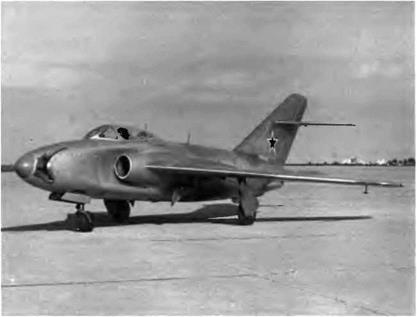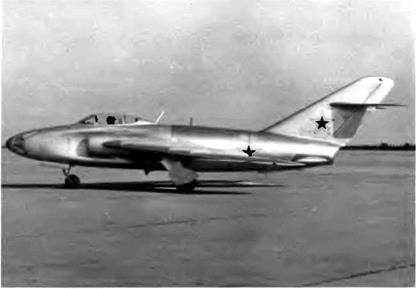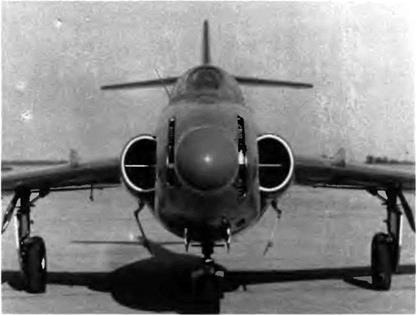MiG-17 / SN
The SN project marked the OKB’s second attempt to develop rotating cannons in the vertical plane. But unlike the experimental SU (a modified MiG-15), in which the cannons’ angular movement was limited by their position under the engine air intake, the rotating cannons on the SN were housed in the aircraft’s nose. This arrangement led to a complete reshaping of the front of the fuselage:
—because the axial engine air intake had to be replaced by two intakes, one on each side of the fuselage, the structure of the nose was modified up to frame no. 13, making the fuselage 1.069 m (3 feet, 6.1 inches) longer
—the main gear was fitted with KT-23 wheels for better braking, and the doors were moved to the sides of the air intake ducts —the cockpit canopy was enlarged to improve the pilot’s view —the fuel capacity was increased by 501 (13 US gallons)
—the instrument panel was rearranged and topped by special sighting equipment
On paper, the SV-25-MiG-17 system was supposed to give the aircraft a decisive advantage. Pointing the fighter toward an intruder is a maneuver that costs a pilot many precious seconds. If he makes even the slightest error or if his adversary proves to be more agile, he has no choice but to withdraw from the engagement. If he chases an enemy aircraft in a curved trajectoiy, the fighter pilot has to point his aircraft toward a point in space ahead of the intruder (a process called target correction). But if the fighter’s angular velocity is too low, its pilot will once more be forced to withdraw. Rotating guns are more accurate and can be pointed toward a predetermined point; moreover, they give the fighter pilot a far better chance to aim and shoot first.
The SV-25-MiG-l 7 system consisted of three 23-mm TKB 495 rotating cannons. The angular displacement of the weapons in the vertical plane (27 degrees, 26 minutes upward, and 9 degrees, 48 minutes downward) was electrically controlled. These experimental guns, developed in Tula by two famed armorers, Afanasyev and Makarov, had a rate of fire of 250 rounds per minute—a record for a single cannon at the time. The whole unit weighed 469 kg (1,034 pounds); the rotating support mount by itself, 142.4 kg (314 pounds); the ammuni-

|

|
|
|
The SV-25-MiG-17 weapons system consisted of three 23-mm cannons, two on the left and one on the right of the fuselage |
tion, 139.7 kg (308 pounds); and miscellaneous equipment, 70 kg (154 pounds).
The experimental SN prototype was the first MiG jet fighter to have lateral air intakes. From the MiG-25 forward, this became the standard arrangement on all MiGs.
The factory tests were conducted by G. K. Mosolov in 1953, and state trials began on 15 February 1954 under GK Nil WS pilots Yu. A Antipov, A. P. Molotkov, N. P. Zakharov, S. A. Mikoyan, V. N. Makhalin, A. S. Saladovnikov, and V. G. Ivanov They completed a total of 130 flights, mainly on a specially modified Ilyushin 11-28 twin-jet bomber; only three of the test flights involved the SN. Thirteen flights were dedicated to firing exercises against ground targets. Altogether, the pilots fired 15,000 rounds with the SV-25-MiG-l 7.
The results of those tests were far from satisfactory to N. I Volkov, MiG’s program manager. The SN’s maximum speed proved to be 60 km/h (32 kt) slower than that of the production MiG-17. Its climb rate had also suffered 0.4 additional minutes were needed to climb to 5,000 m (16,400 feet), and 1.5 additional minutes to climb to 10,000 m (32,800 feet). The aircraft’s service ceiling was almost 500 m (1,640 feet) lower. And to top it all off, the aircraft’s maneuverability had deteriorated. For instance, a tight 360-degree turn could be completed in 77 seconds at best—15 seconds slower than was possible in a production MiG-17.
When the guns were fired, other unpleasant surprises occurred. For example, firing in gusts with the three weapons rotated upward or downward altered the aircraft’s flight path in the opposite direction. It was impossible to fire the cannons at all when the weapons’ slew angle exceeded 10 degrees upward unless special equipment was used to balance the angular momentum of their recoil. The setbacks suffered while experimenting with rotating weaponry on both the MiG-15 and the MiG-17 convinced the OKB once and for all that any such system would be useless if installed too far from the center of gravity in singleseat fighters. All research work in that direction was subsequently abandoned.
The SN was powered by a VK-1A with a rated thrust of 2,645 daN (2,700 kg st).
Specifications
Span, 9.628 m (31 ft 7 in); length, 12.333 m (40 ft 5.5 in); height, 3.8 m (12 ft 5.6 in); wheel track, 3.849 m (12 ft 7.5 in); wheel base, 3.368 m (11 ft 0.6 in); wing area, 22.6 m2 (243.3 sq ft); empty weight, 4,152 kg (9,150 lb); takeoff weight, 5,620 kg (12,385 lb); fuel, 1,455 kg (3,207 lb); wing loading, 248.7 kg/m2 (51 lb/sq ft).
Performance
Max speed, 1,047 km/h at 2,000 m (565 kt at 6,560 ft); 1,058 km/h at 5,000 m (571 kt at 16,400 ft); 1,027 km/h at 10,000 m (555 kt at 32,800 ft); 986 km/h at 12,000 m (532 kt at 39,360 ft); climb to 5,000 m (16,400 ft) in 2.54 min; to 10,000 m (32,800 ft) in 6.9 min; service ceiling, 14,500 m (47,560 ft); range, not recorded.












